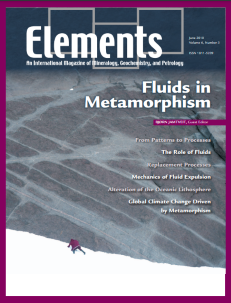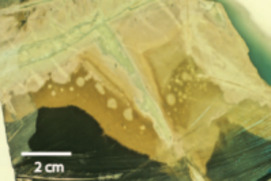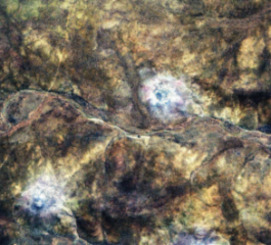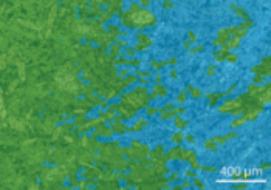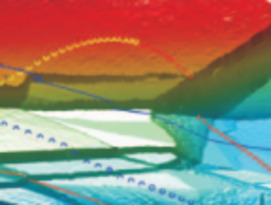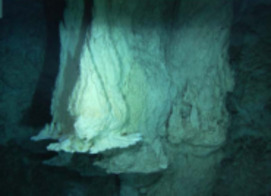
Fluids in Metamorphism
Bjørn Jamtveit – Guest Editors
Table of Contents
Fluids play a critical role during metamorphic processes. They have fi rst-order influence on both reaction kinetics and mass transfer, and thus also on the rate of metamorphism. “Volatile components,” such as H 2 O and CO 2 , may strongly influence rock rheology even in the absence of a free fluid phase. Metamorphic fluids therefore control the coupling between chemical reactions, mass transport, and defor- mation. Microstructures, compositional gradi- ents at various scales, and larger-scale deforma- tion features all reflect the dynamics of fluid–rock interactions. Moreover, the migra- tion of fluids produced during prograde meta- morphic processes or consumed during retro- gression links metamorphism with the hydrosphere, the atmosphere, and the bio- sphere. This issue sheds light on the origin of the various patterns that emerge in metamor- phic rocks as a response to changes in pressure, temperature, and the composition of pore- fi lling fluid. By following the metamorphic fluids to or from the Earth’s surface, we also aim to explain how metamorphism may affect our own environment.
Metamorphism: From Patterns to Processes
Metamorphism: The Role of Fluids
Replacement Processes in the Earth’s Crust
The Mechanics of Metamorphic Fluid Expulsion
Alteration of the Oceanic Lithosphere and Implications for Seafloor Processes
Metamorphic Fluids and Global Environmental Changes
A2 Technologies
The Arkenstone
Attard’s Minerals
Australian Scientific Instruments (ASI)
Bruker AXS
Dakota Matrix Minerals
Excalibur Mineral Corporation
Geological Society of london
Physics of Geological Processes Centre
Rigaku
RockWare
Savillex
Society of Economic Geologists
Thermo Scientific
v6n4 Atmospheric Particles
Guest editor: Reto Gieré
Solid atmospheric particles range in size from a few nanometers to several micrometers and are generated through both natural processes and human activity. Even though these par- ticles are derived from spatially limited source areas and typically become airborne during short-term events, they are ubiquitous globally due to atmospheric circulation. Depending on their physical and chemical properties, these solid aerosols have a major impact on the radiative properties of the atmosphere and gla- ciers, on cloud condensation, and on the chem- ical composition of oceans and soils. Because these particles affect transportation and human health, they have recently become the focus of government attention and regulation. This issue of Elements will explore the atmo- sphere as an exciting new research area for mineralogists and geochemists. It will illus- trate the most prominent types of atmospheric particles and discuss their key effects on cli- mate and ecosystems worldwide.
- Solid Particulate Matter in the Atmosphere Reto Gieré (Albert-Ludwigs-Universität Freiburg) and Xavier Querol (IDAEA-CSIC, Spain)
- Atmospheric Brown Clouds: From Local Air Pollution to Climate Change Guenter Engling (Academia Sinica, Taiwan) and András Gelencsér (University of Pannonia, Hungary)
- Airborne Particles in the Urban Environment Bernard Grobéty (Université de Fribourg), Reto Gieré (Albert-Ludwigs-Universität Freiburg), Volker Dietze (German Meteorological Service), and Peter Stille (Université de Strasbourg)
- Atmospheric and Environmental Impacts of Volcanic Particulates Adam J. Durant (University of Cambridge), Costanza Bonadonna (Université de Genève), and Claire J. Horwell (Durham University)
- Airborne Mineral Dust Johann P. Engelbrecht (Desert Research Institute, Reno, USA) and Edward Derbyshire (Royal Holloway College)
- Interactions between Mineral Dust, Climate, and Ocean Ecosystems Santiago Gassó (University of Maryland Baltimore County), Vicki H. Grassian (University of Iowa), and Ron L. Miller (NASA Goddard Institute for Space Studies)
- Mineral Evolution (February 2010)
- Sulfur (April 2010)
- Fluids in Metamorphism (June 2010)
- Atmospheric Particles (August 2010)
- Thermodynamics of Earth Systems (October 2010)
- Sustainable Remediation of Soil (December 2010)
Download 2010 Thematic Preview


